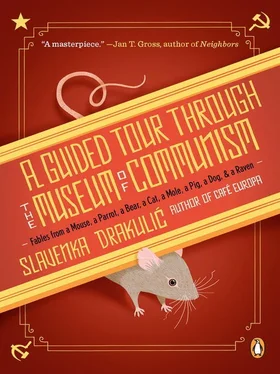In order to fully comprehend this part of the Legend, one has to know that in ancient times these Men living in the Overland were ruled by a great fear of guards and all kinds of uniformed people, as well as Men without uniforms but in powerful positions. To “escape”—i.e., to migrate without permission from the Supreme Authority called the State—was considered a grave and highly punishable offense. However, there were rumors that a certain number of Men managed to obtain such permission and could leave legally, but most of them were old and sick. The Legend does not deal with this specific issue in more detail, but it seems that they were exported just because of the reasons mentioned. It is hard to guess why the Other Side would have wanted Men in such condition if not to demonstrate its charitable intentions. But if these specific categories of Men could have served some other unknown and unimaginable purpose, this knowledge is lost now.
There were thousands of specially trained soldiers and dogs posted all along the Wall. There were 116 watchtowers in order to prevent any attempts at escape, which were anyway numerous. On this point the legend is amazingly specific: some 5,000 men managed to make it to the other side, while 72,000 were jailed for trying to escape. But there is still, to this very day, a dispute about the number of killed escapees, and various versions speak of either one hundred or two hundred. Still, because most Men were not free to leave that Overland country, they feared the police more than the soldiers posted at the Wall. In particular, they feared a kind of secret policeman whose job was to spy on ordinary Men committing any kind of “subversion” (?!) and report on them to the same Supreme Authority. Such spies were called Stasi, and their particular quality was that they were numerous and looked just like ordinary Men, so that you couldn’t tell one from the other. Consequently, as our ancestors noticed, the biggest fear of the escapees in the legendary tunnel was that one of these Stasi might infiltrate their group. Or, perhaps one of 189,000 of their “informal employees.” I must say I do not believe that there could really have been such imminent danger. This looks more like a picturesque addition to the Legend, as it is hard to believe that a Man would go into a tunnel with the sole intention of spying. Incidentally, I also learned that Men use the term “Mole” to describe such a double agent—that is, a person pretending to be a member of the group of escapees while actually working for the police. Needless to say, dear colleagues, I find that usage highly inappropriate, if not insulting.
The Legend of the Berlin Wall lives on because we Moles remembered it and passed it on to our children as a cautionary tale about how strangely Men could behave and how little we know about them. But there are some questions raised in connection with this remarkable endeavor. It seems puzzling why these Men, exactly fifty-seven of them, were so desperate to risk their lives in order to reach the cellar of a former bakery. What was hidden there? Clearly, the answer had to do with the Wall. But why was the Wall there in the first place? I mean, those two walls, of course. Because we tend to forget that there were two Berlin Walls, although the Legend mentions only that the second one was erected later on—with a strip of land in between tellingly called the “Death Strip.” It was deadly only for Men, of course, because according to some versions, there was wildlife there, such as rabbits, mice, birds, and insects, even cats, not to mention our own population. It is said that in those days we even used to mate there. Although safety is always our first priority, we could easily disappear into the Underland in the case of shooting. Unlike Men, for example. Or rabbits, for that matter.
Why that second, parallel Wall was built was something we pondered over for generations. As if one single such construction would not have been enough to prevent people from crossing over? We know that Men are great builders; they like to build all sorts of structures. We therefore assume they built that gigantic Wall in order to protect themselves from their powerful enemies. But even from our underground perspective one could tell that, in their case, there could be no other, more dangerous predators threatening them. It would be strange to have built a Wall for reasons of security. Man is a species without natural enemies, a quite remarkable fact when you come to think about it. Therefore, my hypothesis was (and later you will see why I am using the past tense here) that these two Walls, separated by a strip of wasteland some one hundred meters wide, had no other logical purpose but to divide their hunting territory. “The two walls must have been there because of hunting,” I thought.
Now, what on earth—or, as we Moles would say, what under earth!—was there on the Other Side? What kind of treasure did they want to hunt so eagerly?
In the middle of my research I met Andreas, an elderly, learned Mole who lives in what used to be the West side; as you are aware, for several generations there have formally been no sides. He happened to be the proper person to address some questions to about ancient habits in that part of the Overland. Andreas, of course, was acquainted with the Legend. “Tell me, please,” I asked, “have you found indications of why some people from the East side of the Wall wanted to go to the West?” He looked a bit surprised by my question. “Well, Tillman, have you never heard of the banana issue!?” I had to admit that I was not aware of that aspect of the Legend (by the way, it looked less and less like a Legend to me, the deeper I dug into it). And no—I had never heard about bananas. “What are bananas?” I asked Andreas. “They are a delicacy. You should imagine a banana as an exquisite, extremely succulent, tasty kind of earthworm. Even the mere mentioning of bananas makes Men’s mouth water,” he said. “Oh, I do understand that, the mere thought of a special kind of fat earthworm—and my favorite ones are megadriles from the Tubificidae family—makes my mouth water as well!” I exclaimed, happy to have learned something new.
In the old days, before the Berlin Wall went down, bananas were a very popular food among Men. “But in those days,” Andreas continued, “unlike other popular foods, there was something particular about bananas. While on the West side of the Wall (the banana side, so to speak) Men did not especially appreciate them, probably because they could indulge in them every day; on the nonbanana side they were literally dying for them.” Then he explained to me something crucial: The Men who did not appreciate such fine food enough all lived within the Wall —they were, so to speak, walled-in in West Berlin. In other words, during ancient times Berlin was a kind of prison, albeit a luxury one with plenty of megadriles —I mean, bananas! Bananas seemed to abound there, as they were sent to the prison from somewhere else, where the prisoners’ kinfolk lived. “But it doesn’t make sense that Men in a prison should have such good food like bananas, while those outside, who surely had more access to hunting, would be prepared to risk their lives in order to get it,” I remarked to Andreas. “Well, dear Tillman, don’t forget that we are dealing here with human affairs, strange to us already by definition,” he reminded me.
After this meeting I decided to look more profoundly into the enigma of bananas. I had a premonition that it might be the key to understanding why the Wall had been built. So I looked here and there and found out from varied sources that at that time bananas were so important that Men even cracked so-called banana jokes. The most popular one goes like this: Two Berliner children are speaking to each other over the Wall (but let me remark here that this was hardly possible; the Wall was much too high!). The little boy in the West says, while eating a banana, “Look, I have a banana.” The boy in the East answers: “Yes, but we have socialism!” The boy in the West counters: “We, too, will have socialism soon.” But the boy in the East says triumphantly: “Tough luck, then; you won’t have bananas anymore!”
Читать дальше












